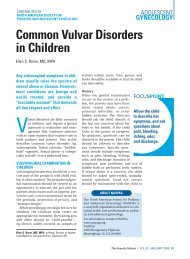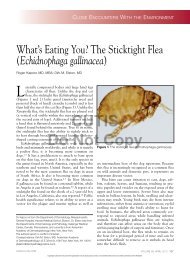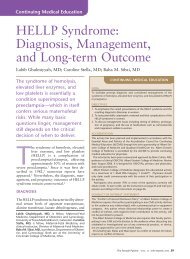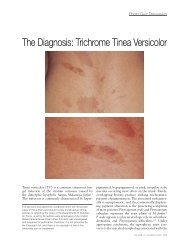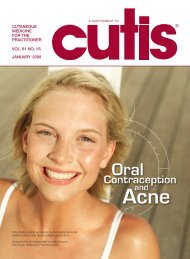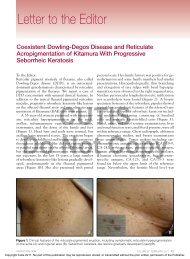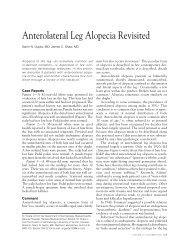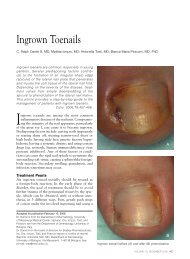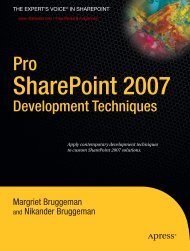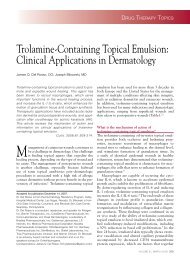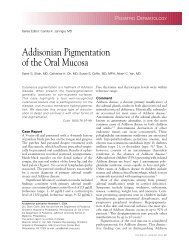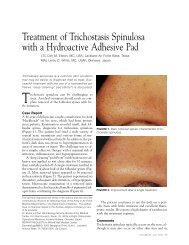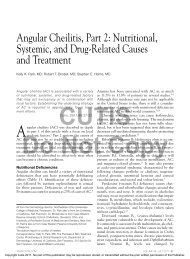Orthopedic Trauma in Pregnancy - The Journal of Family Practice
Orthopedic Trauma in Pregnancy - The Journal of Family Practice
Orthopedic Trauma in Pregnancy - The Journal of Family Practice
Create successful ePaper yourself
Turn your PDF publications into a flip-book with our unique Google optimized e-Paper software.
<strong>Orthopedic</strong> <strong>Trauma</strong> <strong>in</strong> <strong>Pregnancy</strong>Pa<strong>in</strong> ManagementDef<strong>in</strong>itive orthopedic fixation can result <strong>in</strong> significant postoperativeand <strong>in</strong>jury-associated pa<strong>in</strong>. It is common practiceto use narcotics and muscle relaxants <strong>in</strong> the immediateperioperative and postoperative periods to provide comfortto the patient. Naturally, pregnancy raises questions aboutuse <strong>of</strong> such medications.Goodman 21 claimed that perioperative opioid use shouldraise little concern about teratogenicity. <strong>The</strong> risk for neonaterespiratory depression is only pert<strong>in</strong>ent “if deliveryoccurs at the same time as the surgery.” Much <strong>of</strong> the literatureconcern<strong>in</strong>g opioids is <strong>in</strong> the sett<strong>in</strong>g <strong>of</strong> labor pa<strong>in</strong>.A recent systematic review <strong>of</strong> the literature suggested thatepidurals provide better pa<strong>in</strong> relief than systemic medication.However, meperid<strong>in</strong>e (Demerol) is the most commonlyused systemic opioid worldwide, and questions stillexist about its efficacy and side effect pr<strong>of</strong>ile. In addition,none <strong>of</strong> the studies compar<strong>in</strong>g pethid<strong>in</strong>e with other opioidshas been conv<strong>in</strong>c<strong>in</strong>g. 23<strong>The</strong>re are no reports associat<strong>in</strong>g muscle relaxants withteratogenicity. <strong>The</strong> positively charged depolariz<strong>in</strong>g and nondepolariz<strong>in</strong>gagents do not cross the placenta. 22 However,Hart 16 claimed that cyclobenzapr<strong>in</strong>e (Flexeril) is the “onlyknown safe muscle relaxant for use <strong>in</strong> pregnant women.”Nonsteroidal anti-<strong>in</strong>flammatory drugs are contra<strong>in</strong>dicatedbecause <strong>of</strong> their effects on the ductus arteriosus,and they can <strong>in</strong>hibit labor <strong>in</strong> the third trimester. From anorthopedic standpo<strong>in</strong>t, they have been repeatedly shown tobe deleterious to fracture union. <strong>The</strong>refore, acetam<strong>in</strong>ophenis recommended for m<strong>in</strong>or pa<strong>in</strong> relief.Gestational age plays a major role <strong>in</strong> determ<strong>in</strong><strong>in</strong>g whichmedications are safe dur<strong>in</strong>g each phase <strong>of</strong> fetal development.It is important to keep <strong>in</strong> m<strong>in</strong>d that medication risklabels can change dur<strong>in</strong>g a 9-month pregnancy, depend<strong>in</strong>gon the vulnerability <strong>of</strong> the fetus <strong>in</strong> any given trimester. 16“...medication risk labels canchange dur<strong>in</strong>g a 9-monthpregnancy, depend<strong>in</strong>g on thevulnerability <strong>of</strong> the fetus <strong>in</strong> anygiven trimester. 16 ”AnticoagulationVenous thromboembolic disease consists <strong>of</strong> deep venousthrombosis (DVT) and pulmonary embolism (PE). Estimatedannual <strong>in</strong>cidence <strong>in</strong> the general population is approximately0.1%. 24 This percentage is <strong>in</strong>creased 5- to 6-fold <strong>in</strong> pregnancy,as all 3 components <strong>of</strong> the Virchow triad can be found<strong>in</strong> pregnancy. 25 <strong>Orthopedic</strong> trauma, and subsequent operative<strong>in</strong>tervention, can necessitate vary<strong>in</strong>g periods <strong>of</strong> immobilization.Given the hypercoaguable state <strong>of</strong> pregnancy, anticoagulationbecomes a critical issue. In fact, untreated DVTshave been shown to lead to PEs <strong>in</strong> 16% <strong>of</strong> patients and havebecome the lead<strong>in</strong>g cause <strong>of</strong> maternal death. 26 Important riskfactors are listed <strong>in</strong> Table V. 27Choice <strong>of</strong> anticoagulant is <strong>of</strong> critical importance <strong>in</strong> pregnancy.Warfar<strong>in</strong> is known to cross the placenta and potentiallycause fetal bleed<strong>in</strong>g and teratogenicity. 28 Unfractionatedhepar<strong>in</strong> (UFH) has been classified a high-alert drug bythe Institute for Safe Medic<strong>in</strong>e <strong>Practice</strong>s because <strong>of</strong> thepharmacologic properties <strong>of</strong> the agent as well as the risk <strong>of</strong>medical errors <strong>in</strong> anticoagulation management us<strong>in</strong>g UFH.“...untreated DVTs have...become the lead<strong>in</strong>g cause <strong>of</strong>maternal death. 26 ”UFH is associated with hepar<strong>in</strong>-<strong>in</strong>duced thrombocytopenia(HIT), bleed<strong>in</strong>g, and osteopenia with long-term therapy. 29Accord<strong>in</strong>g to a study reported by Hawk<strong>in</strong>s and Evans, 303 <strong>of</strong> every 100 patients on long-term UFH therapy mayexperience symptomatic vertebral fractures, and 30% mayexperience a reduction <strong>in</strong> bone density lead<strong>in</strong>g to osteopeniaand/or osteoporosis.A clear alternative to UFH is low-molecular-weighthepar<strong>in</strong> (LMWH), which is associated with lower <strong>in</strong>cidence<strong>of</strong> HIT and osteoporosis. It is recommended that LMWHdos<strong>in</strong>g be closely monitored with the assistance <strong>of</strong> a pharmacistbecause <strong>of</strong> volume distribution changes encountered<strong>in</strong> pregnancy. 31 It is also recommended that treatment bestopped 24 hours before delivery to allow for safe epiduralanesthesia and to prevent excessive bleed<strong>in</strong>g. 28Another alternative is fondapar<strong>in</strong>ux, a synthetic antithromboticagent that specifically b<strong>in</strong>ds to antithromb<strong>in</strong>.Fondapar<strong>in</strong>ux has been shown to be as effective as LMWHwith respect to anticoagulation and to lack a negative effecton bone. 30Last, a more <strong>in</strong>vasive option is temporary placement <strong>of</strong><strong>in</strong>ferior vena cava filters. Kawamata and colleagues 32 recentlyfound that use <strong>of</strong> this practice <strong>in</strong> 11 patients produced nosymptomatic pulmonary thromboembolism dur<strong>in</strong>g or afterpregnancy. All filters were placed suprarenally and removedsuccessfully, and there were no reported complications.Pelvic and Acetabular <strong>Trauma</strong>In 1980, Golan and colleagues 33 exam<strong>in</strong>ed a series <strong>of</strong> 15patients who susta<strong>in</strong>ed trauma <strong>in</strong> late pregnancy. Five <strong>of</strong>the 15 susta<strong>in</strong>ed pelvic fractures, with the most commonpattern <strong>in</strong>volv<strong>in</strong>g the pubic rami. In this study, fetal outcomeswere mixed, with 2 <strong>of</strong> 5 babies surviv<strong>in</strong>g, 2 deathsoccurr<strong>in</strong>g <strong>in</strong> utero secondary to placental abruption, and 1death occurr<strong>in</strong>g secondary to uter<strong>in</strong>e rupture. However, <strong>of</strong>significance is that the 2 live births, though premature, weredelivered vag<strong>in</strong>ally without adverse events. Authors <strong>of</strong>more recent case reports have described open reduction and<strong>in</strong>ternal fixation <strong>of</strong> acetabular fractures <strong>in</strong> this sett<strong>in</strong>g withgood outcomes. 34,35 Dunlop and colleagues 36 chronicledE164 E162 <strong>The</strong> American <strong>Journal</strong> <strong>of</strong> <strong>Orthopedic</strong>s ®



